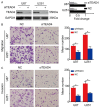Overexpression of TEAD4 correlates with poor prognosis of glioma and promotes cell invasion
- PMID: 31949557
- PMCID: PMC6962916
Overexpression of TEAD4 correlates with poor prognosis of glioma and promotes cell invasion
Abstract
This study aimed to reveal the correlation of increased TEA domain transcription factor 4 (TEAD4) expression and disease prognosis in glioma. The expression data of TEAD4 mRNA in glioma were collected from GEO database (GSE4290), and the expression of TEAD4 protein in glioma was confirmed using western blot and Immunohistochemistry. Kaplan-Meier analysis with the log-rank test was used to reveal the correlation of TEAD4 expression level and patients' survival. The effects of TEAD4 on migration and invasion were separately examined by Transwell assay and Boyden assay. Gene set enrichment analysis (GSEA) was performed to predict the possible biological function of TEAD4 in glioma. The results showed that TEAD4 mRNA and protein expression were upregulated in glioma tissues compared to normal brain tissues. Furthermore, overexpression of TEAD4 correlated with poor prognosis in glioma patients. Knockdown of TEAD4 markedly inhibited glioma cells migration and invasion in vitro. Consistent with the result that TEAD4 was associated with epithelial-mesenchymal transition (EMT) closely by GESA, knockdown of TEAD4 resulted in N-cadherin, vimentin and Slug downregulated but E-cadherin upregulated. Our study indicated that overexpression of TEAD4 may represent as a potential unfavorable marker for poor survival and prognosis in glioma. Knockdown of TEAD4 led to suppressed glioma migration and invasion.
Keywords: EMT; TEAD4; glioma; invasion; migration; prognosis.
IJCEP Copyright © 2018.
Conflict of interest statement
None.
Figures





Similar articles
-
TEAD4 functions as a prognostic biomarker and triggers EMT via PI3K/AKT pathway in bladder cancer.J Exp Clin Cancer Res. 2022 May 17;41(1):175. doi: 10.1186/s13046-022-02377-3. J Exp Clin Cancer Res. 2022. PMID: 35581606 Free PMC article.
-
TEAD4 as a Prognostic Marker Promotes Cell Migration and Invasion of Urinary Bladder Cancer via EMT.Onco Targets Ther. 2021 Feb 10;14:937-949. doi: 10.2147/OTT.S290425. eCollection 2021. Onco Targets Ther. 2021. PMID: 33603398 Free PMC article.
-
Alpha-enolase as a potential cancer prognostic marker promotes cell growth, migration, and invasion in glioma.Mol Cancer. 2014 Mar 21;13:65. doi: 10.1186/1476-4598-13-65. Mol Cancer. 2014. PMID: 24650096 Free PMC article.
-
TEAD4 overexpression suppresses thyroid cancer progression and metastasis in vitro by modulating Wnt signaling.J Biosci. 2022;47:3. J Biosci. 2022. PMID: 34951409
-
TEAD4 overexpression promotes epithelial-mesenchymal transition and associates with aggressiveness and adverse prognosis in head neck squamous cell carcinoma.Cancer Cell Int. 2018 Nov 12;18:178. doi: 10.1186/s12935-018-0675-z. eCollection 2018. Cancer Cell Int. 2018. PMID: 30459528 Free PMC article.
Cited by
-
Hippo Pathway Dysregulation in Thymic Epithelial Tumors (TETs): Associations with Clinicopathological Features and Patients' Prognosis.Int J Mol Sci. 2025 Jun 20;26(13):5938. doi: 10.3390/ijms26135938. Int J Mol Sci. 2025. PMID: 40649713 Free PMC article.
-
Splicing machinery dysregulation drives glioblastoma development/aggressiveness: oncogenic role of SRSF3.Brain. 2020 Dec 5;143(11):3273-3293. doi: 10.1093/brain/awaa273. Brain. 2020. PMID: 33141183 Free PMC article.
-
TEAD4 is a novel independent predictor of prognosis in LGG patients with IDH mutation.Open Life Sci. 2021 Apr 8;16(1):323-335. doi: 10.1515/biol-2021-0039. eCollection 2021. Open Life Sci. 2021. PMID: 33889755 Free PMC article.
-
TEAD4 functions as a prognostic biomarker and triggers EMT via PI3K/AKT pathway in bladder cancer.J Exp Clin Cancer Res. 2022 May 17;41(1):175. doi: 10.1186/s13046-022-02377-3. J Exp Clin Cancer Res. 2022. PMID: 35581606 Free PMC article.
References
LinkOut - more resources
Full Text Sources
Research Materials
